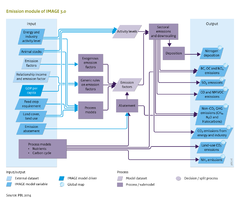Emissions/Description: Difference between revisions
Jump to navigation
Jump to search
m (Text replace - "|Status=On hold" to "") |
No edit summary |
||
| Line 1: | Line 1: | ||
{{ComponentDescriptionTemplate | {{ComponentDescriptionTemplate | ||
|Description===General approaches== | |||
[[Table 5.1]] lists the different sources of emissions included in the IMAGE model. Emissions that are transported in water (nitrate, phosphorus) are discussed in [[Nutrient balances]]. Regarding the approach and spatial detail for modeling gaseous emissions, IMAGE uses four different ways to represent emissions. | |||
* ''World number'' (WRLD). The simplest way to estimate emissions in IMAGE is by using a global estimate from the literature. This approach is used for those natural sources that can not be explicitly modelled. | |||
* ''Emission factor method'' (EF). For other sources in IMAGE, past and future developments in anthropogenic emissions are estimated on the basis of projected changes in relevant economic activities and the emissions per unit of activity (emission factor) ([[Figure 5.1]]). | |||
The equation for this emission factor approach is as follows: | |||
Emission = Activityr,I * EF-baser,i * AF r,i ([[5.1]]) | |||
where Emission is the emission of the specific gas; Activity is the Energy input or agricultural activity, r is the index for region, i index for further specification (sector, energy carrier), EF-base is the emission factor in the baseline and AF is the abatement factor, i.e. the reduction of the baseline emission factor as a result of climate policy. The emission factors are time-dependent, representing changes in technology and air pollution control policies. | |||
The emission factor approach is used to calculate energy emissions and several land-use related emissions. Following equation 5.1, there is a direct relation between the level of economic activity and emission level. Also shifts in economic activity (e.g. use of natural gas instead of coal) may influence the total emissions. Finally, emissions can change as result of changes in the emission factors (EF) or climate policy (AF). Some generic rules are used to describe the changes of emissions over time (see further). The abatement factor (AF) are determined in the climate policy model [[FAIR model|FAIR]] (see [[Climate policy]]). The emission factor approach has some limitations, most importantly that is limited in capturing the consequences of specific emission control technology (or management action) for multiple species (either synergies or trade-offs). | |||
* ''Emission factor method with spatial distribution'' (GEF) represents a special case of the EF method where a proxy distribution is used to present gridded emissions. This is done for a number of sources, for example emissions from animals ([[Table 5.1]]). | |||
• ''Process model''. (GPM). Land-use related emissions of NH3, N2O and NO are calculated with grid-specific models. The models included in IMAGE are simple regression models that generate an emission factor ([[Figure 5.1]]). It should be noted that for comparison with other models, IMAGE also includes the N2O methodology as proposed by IPCC ([[IPCC, 2006a]]). | |||
The approaches used for emissions from energy production and use, industrial processes and land-use related sources are discussed in more detail below. | |||
}} | }} | ||
Revision as of 11:00, 15 January 2014
Parts of Emissions/Description
| Component is implemented in: |
Components:and
|
| Projects/Applications |
| Models/Databases |
| Key publications |
| References |
|
